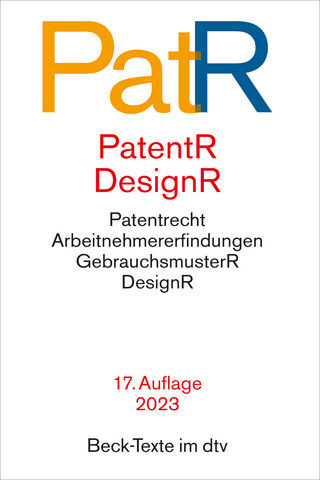
Patents
ISTE Ltd and John Wiley & Sons Inc (Verlag)
978-1-78630-118-5 (ISBN)
This book provides a less Manichaean view of the position of patents in the system of contemporary innovation. It first recalls that these criticisms are not new, before arguing that if these criticisms have been revived, it is because of a partial shift from an integrated innovation system to a much more fragmented and open system. This shift accompanied the promotion of a more competitive economy. The authors show that this movement is coherent with a more intensive use of patents, but also one that is more focused on their signal function than on their function of direct monetary incentive to innovation.
Marc Baudry, University of Paris-Nanterre, France. Béatrice Dumont, Sorbonne Paris Cité, France.
Introduction ix
Chapter 1 The Purpose of Patents 1
1.1 Introduction 1
1.2 Patents as an incentive mechanism 2
1.2.1 The key question of appropriability of returns for innovation 3
1.2.2 Patents as a solution for the lack of appropriability 7
1.2.3 Patents and their design 11
1.2.4 Are patents a property right like any other? 22
1.3 Patents as intangible assets 26
1.3.1 From factory to fabless: the growing role of the obligation to disclose the content of patents 27
1.3.2 The emergence of patents as intangible assets 30
1.3.3 The delicate question of assessing patents as intangible assets 33
1.3.4 Patents as funding leverage 40
1.3.5 The commoditization of patents 44
1.4 Case study: Intellectual Ventures Inc 51
Chapter 2 The Imprimatur of Patent Offices in the Face of Reforms 55
2.1 Introduction 55
2.2 The exponential demography of patents 56
2.3 The impact of regulatory factors and legal decisions in the United States 66
2.3.1 Patent continuations or “evergreening” 72
2.3.2 Reform attempts 74
2.4 Regulatory developments in Europe 94
2.4.1 The unitary patent and the unified court: the final stage of a European patent system? 97
2.4.2 The supposed economic advantages of the unitary system 103
2.4.3 From intention to reality 106
Chapter 3 The Judiciarization of Patents 111
3.1 Introduction 111
3.2 Should patent trolls be tracked down? 113
3.2.1 A class of heterogeneous actors 115
3.2.2 The business model of litigation PAEs 117
3.2.3 What is the scale of this phenomenon? 121
3.2.4 The consequences for innovation 126
3.2.5 A longstanding and potentially beneficial role 129
3.2.6 Proposals for reforms 134
3.3 Standards and patents: a necessary but tense coexistence 135
3.3.1 FRAND licenses as safeguards for essential patents 136
3.3.2 The hold-up theory faced with the facts 139
3.3.3 The availability of injunctions 145
3.3.4 Patent ambushes 159
3.3.5 Royalty-stacking 162
3.3.6 “Best FRAND forever” or the delicate question of royalty amounts 164
3.4 Case study: sovereign patent funds 172
Chapter 4 A New Place under the Sun for Patents? 177
4.1 Introduction 177
4.2 The patent as one innovation policy instrument among many 178
4.2.1 Innovation awards, or how to rehabilitate an old approach 179
4.2.2 Could innovation awards replace patents? 182
4.2.3 Complementarity with support for R&D efforts 187
4.2.4 An example of complementarity between instruments: low-carbon innovation 189
4.3 Patents in support of open innovation strategies 192
4.3.1 Patent pools as a premise for open innovation 193
4.3.2 From R&D cooperation to open innovation 198
4.3.3 Why is open innovation so “patent-compatible?” 204
4.3.4 Patents at the center of intermediate innovation 208
4.4 Case study: “My patents are yours” – development in the Tesla case 211
Conclusion 217
Bibliography 221
Index 251
| Erscheinungsdatum | 21.10.2017 |
|---|---|
| Verlagsort | London |
| Sprache | englisch |
| Maße | 162 x 238 mm |
| Gewicht | 544 g |
| Themenwelt | Recht / Steuern ► EU / Internationales Recht |
| Recht / Steuern ► Wirtschaftsrecht ► Urheberrecht | |
| Wirtschaft ► Betriebswirtschaft / Management ► Unternehmensführung / Management | |
| ISBN-10 | 1-78630-118-0 / 1786301180 |
| ISBN-13 | 978-1-78630-118-5 / 9781786301185 |
| Zustand | Neuware |
| Informationen gemäß Produktsicherheitsverordnung (GPSR) | |
| Haben Sie eine Frage zum Produkt? |
aus dem Bereich


